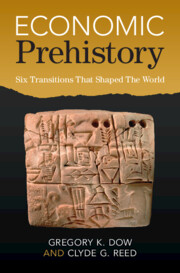Book contents
- Economic Prehistory
- Economic Prehistory
- Copyright page
- Dedication
- Contents
- Figures
- Tables
- Preface
- Acknowledgments
- Abbreviations
- Part I Prologue
- Part II Sedentism and Agriculture
- Part III Inequality and Warfare
- Part IV Cities and States
- 9 Mesopotamian City-States
- 10 Mesopotamian City-States
- 11 The Emergence of Cities and States
- Part V Epilogue
- References
- Author Index (Abridged)
- Subject Index
11 - The Emergence of Cities and States
from Part IV - Cities and States
Published online by Cambridge University Press: 10 February 2023
- Economic Prehistory
- Economic Prehistory
- Copyright page
- Dedication
- Contents
- Figures
- Tables
- Preface
- Acknowledgments
- Abbreviations
- Part I Prologue
- Part II Sedentism and Agriculture
- Part III Inequality and Warfare
- Part IV Cities and States
- 9 Mesopotamian City-States
- 10 Mesopotamian City-States
- 11 The Emergence of Cities and States
- Part V Epilogue
- References
- Author Index (Abridged)
- Subject Index
Summary
This chapter reviews the literature on the origins of cities and states. We argue that purely agricultural societies are unlikely to have cities because population dispersal reduces travel costs for farmers and herders. But incentives for agglomeration could arise from the productivity of urban manufacturing, the need for collective defense, or cultural factors. We supplement our study of Mesopotamia with archaeological data on state formation in Egypt, the Indus Valley, China, Mesoamerica, and the Andes. All of these cases had highly productive food technologies, pre-existing stratification, and close links with urbanization. Based on our models in Chapters 6, 8, and 10, we suggest three pathways to a state. In the “property rights hypothesis,” improving food technology and long-run population growth lead to the creation of elite property rights over the best sites, a shrinking commons, and falling commoner wages. This eventually triggers urban manufacturing and city-state formation. In the “elite warfare hypothesis,” warfare among elites over land rents causes defensive agglomeration in cities and territorial expansion by successful elites. In the “environmental shift hypothesis,” commoner populations migrate toward refuge sites (often river valleys) controlled by local elites, again leading to falling commoner wages, urbanization, and state formation.
Keywords
- Type
- Chapter
- Information
- Economic PrehistorySix Transitions That Shaped The World, pp. 435 - 482Publisher: Cambridge University PressPrint publication year: 2023

